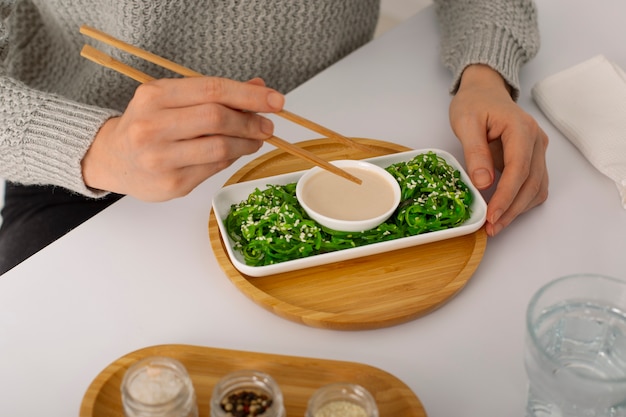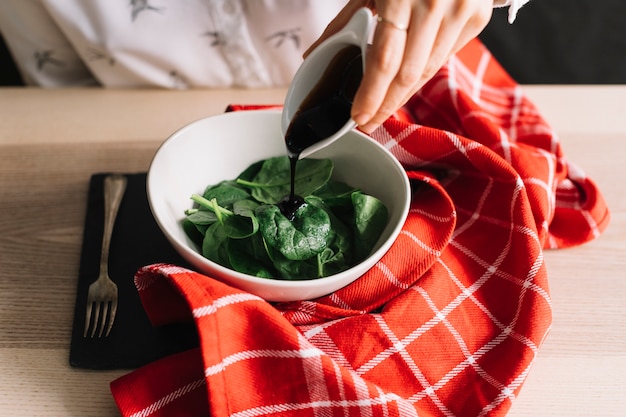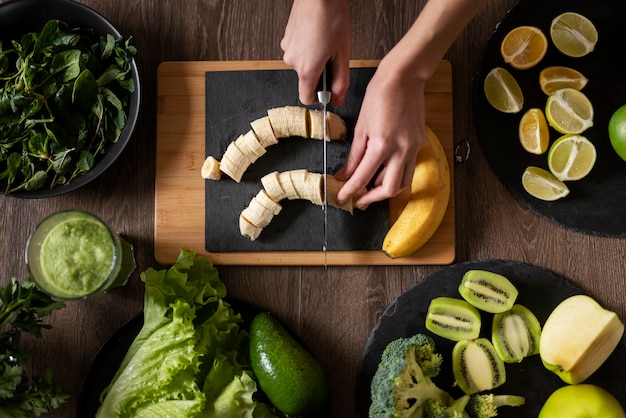Spinach. It's a staple in my kitchen, a green powerhouse that adds a vibrant touch to countless dishes. But let's be honest, sometimes it feels like a bit of a culinary tightrope walk. One wrong move, and you're left with a sad pile of mushy spinach. No one wants that! So, today we're diving into the world of spinach cooking time, demystifying the process and discovering the secrets to achieving perfectly cooked spinach that's bursting with flavour and texture.
Part 1: The Spinach Dilemma

Spinach is a culinary chameleon. It can be a vibrant, crunchy addition to salads, a delicate element in creamy soups, or a hearty base for comforting stews. But its delicate nature makes it a bit tricky to master. Overcook it, and it transforms from a vibrant green to a sad, limp mess. But get it right, and spinach can truly shine!
The Importance of Timing
The key to success lies in mastering the art of timing. It's all about knowing when to stop, when to pull that pan off the heat before the spinach turns into a soggy, flavorless mess. It's like a delicate dance, a culinary ballet between heat and greens.
Part 2: Unveiling the Methods

There are several ways to cook spinach, each with its own unique charm and timing considerations. Let's explore the most common methods, revealing the secrets to achieving the perfect texture and flavour.
1. Sautéing: A Quick and Easy Classic
Sautéing spinach is a simple and quick method, perfect for everyday meals. It's all about tossing the leaves in a hot pan with a touch of oil or butter, letting the heat work its magic. But watch closely, as it can go from vibrant green to overcooked in a blink. Here's how I do it:
- Heat It Up: Start by heating a drizzle of oil or a knob of butter in a large skillet over medium-high heat. You want the pan nice and hot, ready to kiss the spinach.
- Add in Handfuls: Toss in your washed spinach, a handful at a time. Don't crowd the pan, or it'll steam instead of sauté. Give the leaves some room to breathe!
- The Dance Begins: Stir the spinach constantly, gently tossing it around the pan for about 2-3 minutes. You're looking for the leaves to wilt down to about half their original size and turn a vibrant, glossy green.
- Time to Stop: As soon as the spinach reaches that beautiful bright green, remove it from the heat immediately. Don't let it linger!
- Season and Enjoy: Season the spinach with salt and pepper, or any other seasonings that suit your fancy.
Remember, you want your spinach to retain a slight bite, a subtle crunch that adds to its textural delight. Don't let it become limp and lifeless!
2. Steaming: A Gentle Touch for Delicate Flavor
For a lighter, more delicate approach, steaming is the way to go. It's like giving your spinach a luxurious spa treatment, preserving its vibrant colour and delicate flavour.
- Boiling Water: Bring a pot of water to a rolling boil.
- Steam it Up: Place a steamer basket over the boiling water. The steam will do the magic.
- Add the Spinach: Gently add your washed spinach to the steamer basket.
- Cover and Cook: Cover the pot and steam for 2-3 minutes, or until the spinach has wilted and is tender.
- Time to Serve: Remove the steamer basket from the pot and carefully transfer the spinach to a serving dish.
Steamed spinach has a subtle flavour, making it perfect for incorporating into salads, soups, or other dishes where you want the spinach to play a supporting role, adding a touch of colour and a subtle green flavour.
3. Blanching: A Flash of Heat for Vibrant Color
Blanching is a quick cooking method that's perfect for preserving the vibrant green colour of spinach. It's like a quick dip in a hot bath, just long enough to soften the leaves while maintaining their bright colour.
- Boil the Water: Bring a large pot of salted water to a rolling boil.
- Dip and Cook: Add your washed spinach to the boiling water.
- Time It Right: Cook for about 30 seconds, or until the spinach has wilted and turned a brilliant green.
- ice bath: Immediately drain the spinach in a colander and plunge it into a bowl of ice water to stop the cooking process. This ice bath helps preserve the vibrant colour and prevents the leaves from continuing to cook.
Blanched spinach is a versatile ingredient. Add it to salads, soups, or use it as a side dish. Its vibrant colour and slightly crisp texture will make it a visual and culinary delight on your plate.
4. Microwaving: A Quick and Convenient Shortcut
Yes, you can microwave spinach! It's a quick and convenient method for those busy weeknights when time is of the essence. Just make sure not to overcook it.
- Prepare the Spinach: Place your washed spinach in a microwave-safe bowl.
- Add a Splash of Water: Add a tablespoon or two of water to help with steaming.
- Cover and Vent: Cover the bowl with a microwave-safe lid or plastic wrap, leaving a vent for steam to escape.
- Microwave: Microwave on high for 1-2 minutes, or until the spinach has wilted and is tender.
Microwaved spinach is perfect for quick and easy meals, like pasta dishes or stir-fries, where you don't want to spend time standing over a stove.
Part 3: Factors that Influence Cooking Time

Now that we've explored the cooking methods, let's delve into the factors that can affect spinach cooking time. These are the variables that can make the difference between perfectly cooked spinach and a soggy mess.
1. The Amount of Spinach: More Leaves, More Time
The more spinach you're cooking, the longer it will take. It's like a crowd in a kitchen – more people, more time it takes to get everyone fed.
2. Freshness Matters: Vibrant Leaves Cook Quicker
Fresh, vibrant spinach will cook faster than older, wilted spinach. The fresher the spinach, the quicker it will wilt. So, always use the freshest ingredients possible for the best results.
3. Leaf Thickness: Thin Leaves Cook Faster
Baby spinach, with its delicate, thin leaves, will cook faster than mature spinach with thicker leaves. The thinner the leaves, the quicker they'll wilt.
4. Cooking Method: Each Method Has its Own Time
As we've already seen, each cooking method has its own ideal cooking time. Sautéing will be quicker than steaming, while blanching is a flash-cooking method designed for speed.
5. Heat Level: High Heat, Faster Cooking
The hotter your pan or water, the faster the spinach will cook. So, if you're impatient, crank up the heat! But keep a watchful eye, as high heat can easily lead to burnt spinach.
Part 4: The Telltale Signs of Overcooked Spinach
We've covered the basics, but now let's talk about the signs of overcooked spinach. These are the red flags that signal you've gone too far and your spinach has lost its vibrant, delicious appeal.
- Dull, Dark Green Colour: Overcooked spinach loses its bright, glistening green hue and turns a dull, dark green. It's like it's lost its sparkle.
- Soggy, Mushy Texture: Overcooked spinach becomes limp and soggy, with a mushy texture. It's like it's lost its fight.
- bitter taste: Spinach can become bitter when overcooked. It's not a pleasant experience, trust me!
- Nutrient Loss: Overcooked spinach loses some of its essential vitamins and minerals. It's like it's giving up on life!
If you see any of these signs, you've gone too far. But don't despair! There are a few things you can do to rescue your overcooked spinach.
Part 5: Rescuing Overcooked Spinach: A Culinary First Aid
So, you've overcooked your spinach. Don't panic! There are a few tricks up our sleeve to salvage your culinary disaster.
- Cold Water Rescue: If you've overcooked your spinach in a pan, immediately remove it from the heat and add a splash of cold water. This will help to stop the cooking process and cool the spinach down.
- Drain and Refresh: Drain the spinach in a colander and run cold water over it to remove any excess water and cool it down. It's like giving it a quick shower.
- Use It in Other Dishes: Overcooked spinach can still be used in other dishes, like soups or stews, where the texture won't be as noticeable.
- Don't Throw It Out: Unless it's completely burnt, overcooked spinach can still be eaten. Just be aware that it may have a less appealing texture and flavour.
Remember, prevention is always better than cure. Keep a close eye on your spinach and avoid overcooking it in the first place.
Part 6: Perfect Spinach Techniques: My Tried-and-True Tips
Here are some of my tried-and-true techniques for achieving perfectly cooked spinach, based on years of culinary adventures (and some mishaps).
- Don't Overcrowd the Pan: Make sure you have enough space in your pan for the spinach to wilt properly. Overcrowding will cause it to steam instead of sauté.
- Stir Constantly: To ensure even cooking, stir the spinach constantly. It's like a dance, a waltz with your leafy greens.
- Cook in Batches: If you have a large amount of spinach, cook it in batches. This will help ensure that all the spinach cooks evenly.
- Season After Cooking: Season your spinach after it's cooked. This will help prevent it from becoming soggy and will allow the flavours to develop.
- Don't Overcook: This may sound obvious, but it's important to remember that spinach cooks very quickly. Take it off the heat as soon as it's wilted and tender.
Part 7: Spinach in Your Culinary Repertoire
Now, let's talk about all the wonderful ways you can use spinach in your cooking. It's incredibly versatile, perfect for both savoury and sweet dishes.
Savoury Dishes: Spinach's Savoury Side
Here are some ideas to get your culinary juices flowing:
- Salads: Add spinach to salads for a boost of nutrients and a bright, fresh flavour.
- Soups: Spinach is a great addition to soups, both creamy and clear. It adds a beautiful green colour and a delicate flavour.
- pasta dishes: Toss spinach into your favourite pasta dish for a healthy and flavourful addition.
- Stir-fries: Spinach is a staple ingredient in stir-fries, adding colour, texture, and a touch of sweetness.
- Quiches and Tarts: Spinach is a classic filling for quiches and tarts, adding a savoury and earthy flavour.
- pizza toppings: Spinach is a delicious and healthy pizza topping. It's great with both white and red sauce pizzas.
- Burgers and Sandwiches: Add spinach to your burgers or sandwiches for a burst of flavour and a healthy twist.
- Dips and Spreads: Use spinach in dips and spreads for a vibrant green colour and a fresh flavour.
Sweet Dishes: Spinach's Sweet Surprise
Yes, you read that right! Spinach can be used in sweet dishes too.
- Smoothies: Add spinach to your smoothies for a hidden dose of greens. You won't even taste it!
- Muffins and Breads: Incorporate spinach into muffins or breads for a healthy and delicious twist.
Part 8: storing spinach: Keeping it Fresh
Proper storage is essential for keeping spinach fresh and vibrant.
- Refrigerate Immediately: Store spinach in the refrigerator as soon as you get it home.
- Wash Before Storing: Wash spinach before storing to prevent it from spoiling.
- Use a Storage Bag: Place washed spinach in a resealable plastic bag or container.
- Remove Excess Air: Squeeze out as much air as possible from the bag or container.
- Crisper Drawer: Store spinach in the crisper drawer of your refrigerator, where it will stay fresh for up to a week.
Part 9: FAQs: Your Spinach Questions Answered
Here are some frequently asked questions about spinach:
1. How long does it take to cook spinach?
The cooking time for spinach will vary depending on the method you're using. Sautéing takes about 2-3 minutes, steaming takes 2-3 minutes, blanching takes 30 seconds, and microwaving takes 1-2 minutes.
2. How do I know if spinach is cooked?
Spinach is cooked when it's wilted and tender. It should also be a bright green colour. Avoid overcooking, which will result in a dark green colour and a mushy texture.
3. Can you freeze spinach?
Yes, you can freeze spinach. Blanch the spinach first to help preserve its colour and texture. Then, squeeze out as much excess water as possible and place the spinach in a freezer-safe bag or container. Frozen spinach can be stored for up to 6 months.
4. What are the health benefits of spinach?
Spinach is a nutrient-rich vegetable that is packed with vitamins, minerals, and antioxidants. It's a good source of vitamin A, vitamin C, vitamin K, iron, folate, and magnesium. Spinach has been linked to several health benefits, including improved eye health, reduced risk of chronic diseases, and better bone health.
5. Is there a substitute for spinach?
Yes, there are a few substitutes for spinach. Kale, collard greens, and chard are all good alternatives. They have a similar nutritional profile to spinach and can be used in many of the same recipes.
So there you have it! We've demystified the art of cooking spinach, from the basics to the tips and tricks. Now, go forth and cook your spinach with confidence, knowing you've got the tools to make it shine!
Everyone is watching

Prime Rib Roast Cooking Time Chart: Per Pound Guide
Cooking TipsPrime rib roast. Just the name conjures images of lavish dinners, crackling fires, and hearty laughter. It’s ...

How Long to Bake Potatoes in the Oven (Perfect Every Time)
Cooking TipsBaked potatoes are a staple in my kitchen. They're incredibly versatile, delicious, and surprisingly easy to m...

Perfect Rice Every Time: The Ultimate Guide to Cooking Rice
Cooking TipsAs a self-proclaimed foodie, I've always been a bit obsessed with rice. It's the foundation of countless cuisi...

The Ultimate Guide to Cooking Asparagus: Tips, Techniques, and Recipes
Cooking TipsAsparagus. The mere mention of this spring delicacy conjures up images of vibrant green spears, crisp and burs...

Ultimate Guide to Cooking the Perfect Thanksgiving Turkey
Cooking TipsThanksgiving. Just the word conjures up images of overflowing tables laden with delicious food, the scent of r...
